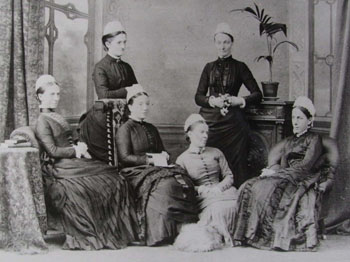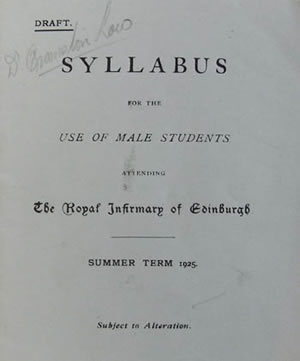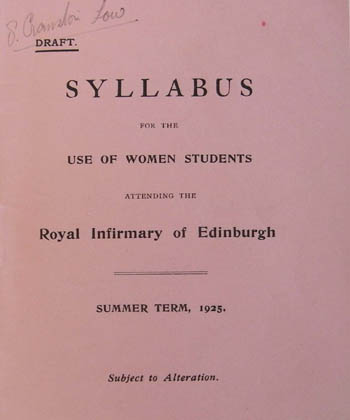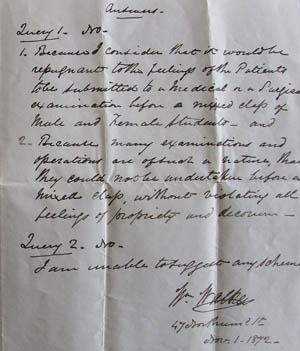Tales Archive
The Story of the 'Sick Kids' Hospital
Tales from the Archive
Women and the Royal Infirmary of Edinburgh, 1870-1950
This was a period of huge change in medicine, and with the opening of the then brand new building at Lauriston Place in 1879, the Royal Infirmary of Edinburgh (RIE) was at the forefront of healthcare in Edinburgh. At this time, not one but two revolutions were underway for women associated with the Infirmary: radical changes to nursing and the challenge for women to receive medical training.
Nurses
Florence Nightingale’s Training School for Nurses at St Thomas’ Hospital in London was opened in 1860. This introduced a greater degree of professionalism to nursing, turning it into a career for educated women. There was a movement to formalise procedures and create high standards for all nurses to attain. Taking note of these changes, the managers of the RIE instituted a probationary period of training and a higher wage to attract “a better class of woman” to the profession. A Lady Superintendent of Nurses, Elizabeth Barclay, was appointed in 1872, and the RIE Nurse Training School was founded in the same year. The School gained an excellent training reputation, and RIE-trained nurses went on to take up positions the world over.

Elizabeth Barclay and her Nightingale nurses. LHSA reference: FN Staff P331
Female Medical Students
Whilst these changes in nursing were taking place, another set of women were fighting hard to overcome institutional barriers. Female medical students, led by Sophia Jex Blake, recently given permission to receive a medical education at the University of Edinburgh in 1869, were effectively prevented from completing their training when the RIE refused to allow women the clinical instruction necessary for qualification. Whilst a wider public debate raged on the issue, Peter Bell, clerk to the managers sent a letter to all medical and surgical staff asking whether they were in favour of admitting female students on the same terms, and at the same times, as male students. Of the 19 responses we hold in the Archive, only three were in favour. William Walker’s letter typifies the response of the majority; not only did he think that examination by a mixed class of students would be “repugnant to patients” but also that “many examinations and operations are offensive in nature and could not be undertaken before a mixed class without violating the feelings of propriety and decorum”. Despite this, in December 1872, the Board passed a motion to allow female matriculated students of the University to receive clinical instruction but at a separate hour to the male students and only in certain wards. They were not permitted to view post-mortems, to see major surgical operations nor to act as clerks and dressers.
William Walker’s letter (click on the image to view a larger version). LHSA reference: LHB1/73/1/7
Female Medical Graduates
This did not deter an increasing number of women from gaining medical degrees. Over time, female medical students achieved more concessions and larger numbers of women began to apply to study medicine. During the First World War, there was a sizeable increase in the numbers of women matriculating as medical students, rising from 106 (versus 962 men) in 1914-15, to 373 (versus 1,310 men) in 1918-19. Provision was made at this time to, as far as possible, allow instruction on the same basis as men. Medical and surgical staff were depleted, some on foreign service and those at home were overworked, often doing extra work in the war hospitals that had sprung up in the city. It was not until 1927, however, that female medical students were able to obtain clinical instruction on medical wards in mixed classes. And it would be a further nine years before the same was true of the surgical wards. Differences were highlighted in not so subtle ways as the syllabus booklets below show.
 |
 |
Can you spot the women's syllabus? LHSA references LHB1/113/1/1-2
Residency at the RIE
As well as being able to receive clinical instruction and graduate in medicine, women wanted the right to apply for residency at the RIE. After graduation a medical student had to serve a practical apprenticeship. To do this he or she had to obtain an approved appointment as a resident House Officer in a hospital. Residencies at the RIE were considered to be prestigious, although before 1948 the position was unsalaried. The usual period of service was six months, rising to 12 months in 1950, six of which were spent attached to medical wards, and six to surgical wards. Although female residents were admitted from the 1920s, they were not permitted to live in the Residency itself. In the 1940s, this led to another fight for the female residents to be allowed to live in the Residency ‘mess’ (the residents lived within the Infirmary building in the Residency, each new intake forming a separate ‘mess’). The Residency contained a sitting room and a dining room as well as bedrooms. Food was supplied from the Hospital kitchens. A letter from 1945, written by the mess secretary, shows that a proposal to allow women to live in the mess was not very popular. In fact, they viewed it “with much concern and annoyance”. Women did eventually win the right but were allowed access to only one bathroom upstairs and were not permitted to attend the two annual formal dinners!
It’s easy to take for granted the standards of service we have in nursing today, and the equality of opportunity for men and women to obtain medical training. This has not always been the case and we owe a debt of gratitude to those first women who paved the way and challenged societal norms.
Designed by the Learning Technology Section, © The University of Edinburgh


